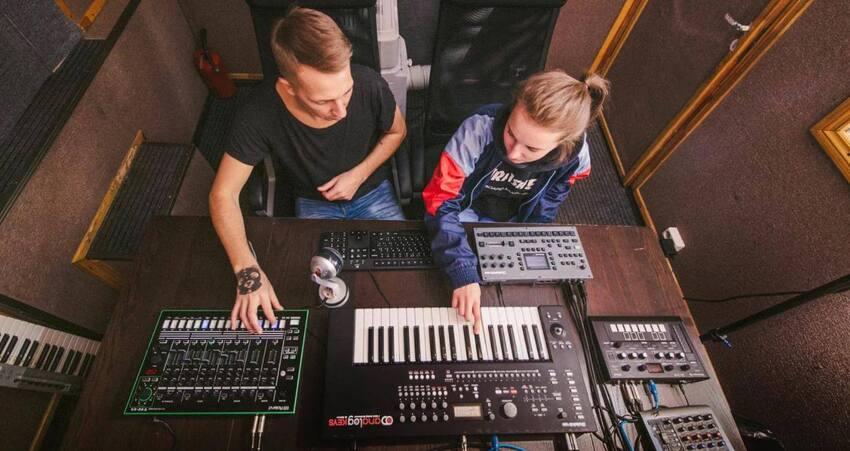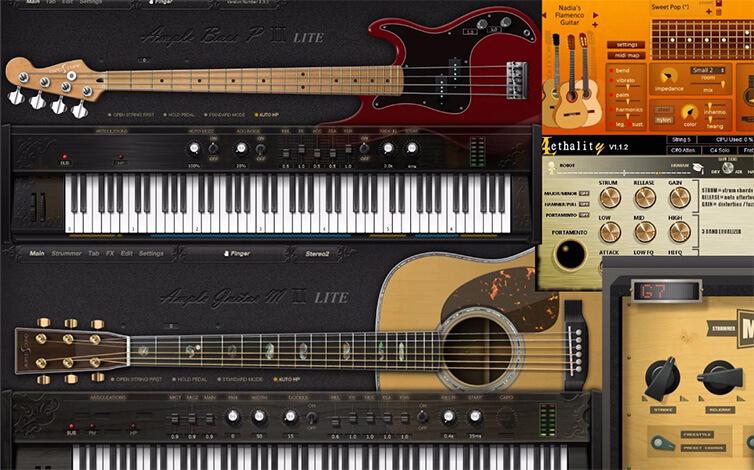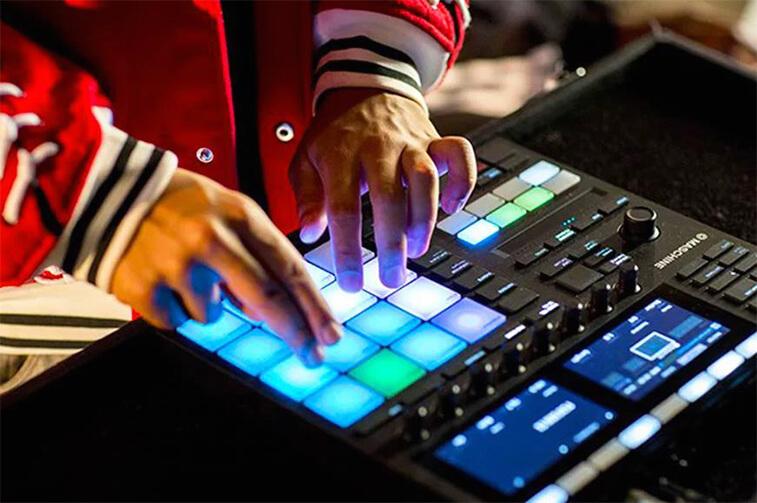Best delay VST

Like the continuous vibrations of an endlessly multiplying tape, delay plug-ins are a vast collection of tools that seem endless in the variety available to modern music producers. However, among this multitude, only the best delay plugins are able to accomplish what everyone else cannot. Whether it’s simulating the sound of classic magnetic tape with all its characteristic noise and vibrations, or digital delays, giving you endless customization possibilities in the three-dimensional sound space and on the equalizer spectrum.
Delay plugins can solve a variety of production problems for creative musicians. You can use them to add depth and dimension to your compositions, add warmth and make them stand out in the context of your music mix. Or you can send your tracks into another dimension, where wild, endlessly repeating sound waves can mesmerize even the most passionate connoisseurs of audio experimentation.
Before we dive into the most advanced delay plugins, let’s discuss the variety of delay effects available and why you should choose one over the other for your music mix.
Tape delay
The concept of tape delay originated in the early 20th century with the advent of tape recorders. The idea was to record a dry signal on magnetic tape before playing it back in the future. Thanks to the characteristics of the tape, the sound was warm and smooth. Unfortunately, today it is almost impossible to find tape delays in good condition for a reasonable price. But if you want a warm, vintage sound, it’s recommended to look into plugins that emulate tape delays. Many of them recreate the original equipment, allowing you to get closer to the sound of the tape delays used in your favorite tracks.
Analog delay
Analog delay devices emerged in the 1970s as an alternative to magnetic tape, as tape was extremely unstable and required a lot of effort to maintain operation. Analog delay effects are renowned for their warm and distinctive sound characteristics. If you listen to classic rock, then you’re probably familiar with those analog delay effects that can be heard everywhere.
Digital delay
Digital delays emerged in the 1980s with the development of electronic music and hard rock. This gave developers the ability to create delay effects using computer algorithms. This transition not only expanded the range of new sound textures for musicians and sound engineers, but also greatly simplified the work with delays.
Hybrid delay / Modern delay
There are a huge number of plugins that aim to emulate classic delay effects. However, there are also many developers who go further and create innovative sound effects that have never been seen before.
1. Waves H-Delay
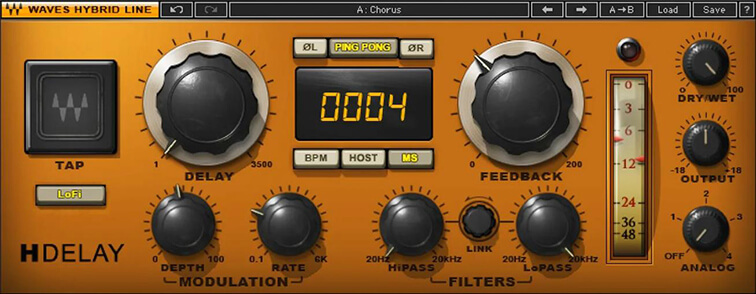
Waves calls H-Delay a “hybrid” delay plugin because it offers a variety of sonic characteristics depending on your needs. But let’s be honest, it sounds so analog that sometimes you can forget about its digital nature.
The main advantage of this plugin is its simplicity. There are no confusing menus or unnecessary screens. All settings are presented as large knobs, giving it the visual vibe of a classic analog delay.
The nature of this effect is best described as analog or lo-fi. You’ll find four different delay modes and a lo-fi switch that adds that signature crunch and darkness to your sound. Additionally, there are several modulation controls at the bottom of the interface, which are great for creating a smooth chorus effect.
H-Delay is one of my favorite delays for ping-pong effects, especially when it comes to vocals, percussion, or synths with a lot of transients. Of course, if you just want a good delay for a slap effect or a precise 1/16th note delay, the H-Delay does a great job of that too.
Be sure to play around with the delay parameter in this plugin and try automation in your mix to create expressive dub-inspired pitch changes or a vibrant reverse effect.
2. UAD Galaxy Tape Echo
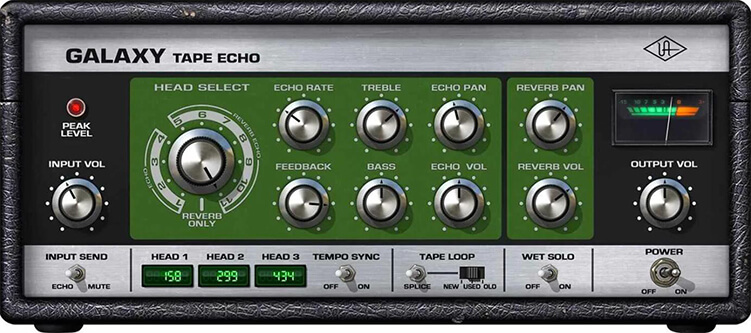
The UAD Galaxy Tape Echo is based on one of the most legendary tape delays in music history, the Roland RE-201 Space Echo. This unique plugin accurately captures all the amazing features of the original hardware while providing a convenient configuration that you can customize to your liking.
The sound of Galaxy Tape Echo can be described as rich, warm and surprisingly smooth. Many artists such as Pink Floyd and David Bowie have often used the source device to create their unique sounds, and this plugin successfully captures that distinctive sound signature.
Tape echo has always been known for its soft and warm sound, which makes it not the best choice for rich mixes. However, if you’re into electronic music and want to add a warmer edge to your digital instruments, or if your style of music is closer to minimalism such as folk, reggae or acoustic music, then this effect can give your sound a unique character that will help highlight different elements. your mix.
3. Slate Repeater Delay

The Slate Repeater Delay may look like a classic digital delay device, but its capabilities include a variety of delay effects such as digital, analog, and tape delays, among many others.
There are 23 different emulations available in this amazing delay plugin, covering a wide range of iconic devices. Additionally, within the plugin there is a built-in EQ and panning controls, allowing you to control the stereo image and delay character before it fits into your mix.
Particularly useful is that you can individually adjust different aspects of the stereo sound, which is a unique way to create a wide sound space.
While the two previously mentioned plugins have a narrower scope, Slate Repeater Delay is a versatile tool for creating standard and classic delay effects. Whether it’s adding space to synths or giving vocals a ’50s-style slap effect, this delay plugin is one of the best in its class.
4. UAD Cooper Time Cube MKII Delay

I’ve always liked the look and feel of UAD plugins. Somehow, the UAD developers manage to make their plugins feel more tangible, which I think is great, especially since they are designed to emulate classic audio hardware.
The Time Cube MKII delay is designed in the style of old rack units and has all the same features you’d expect from the original equipment, plus additional features including pan controls and envelope shapers.
Despite the many features, one of my favorite ways to use this plugin is to create slapbacks. For some inexplicable reason, the algorithm used in this plugin is able to expand and enhance vocal parts without taking up much space, which is truly amazing.
5. Valhalla Delay
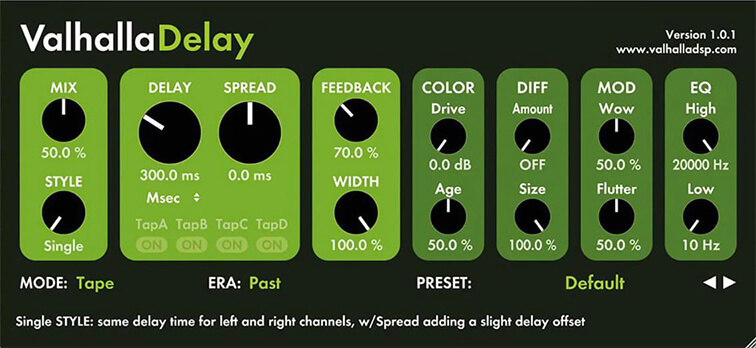
Valhalla certainly sticks to its unique aesthetic, as Valhalla Delay maintains the same style as all other Valhalla plugins with its minimalistic yet striking design. However, despite its modern appearance, this plugin provides the sound of analog devices from decades past.
In my opinion, Valhalla Delay is one of the best delay plugins for those looking to recreate the unique sound of classic delays while maintaining the control only available with a digital plugin. One of the aspects that has always impressed me about Valhalla’s designs is their creativity, and this plugin really lives up to that reputation.
If you want a classic tape echo or analog sound, then it may be worth considering other plugins. However, if you crave something unique and special in the world of sound, then Valhalla Delay is your choice.
If you’re using this plugin and not experimenting with the great modulation capabilities, then you’re missing out on something important. Simply turn the diffusion control all the way up and you’ll create a unique hybrid sound that combines reverb and delay characteristics that will add incredible space to your mix.
6. Soundtoys PrimalTap

Soundtoys is one of my favorite effects plugin makers, and PrimalTap is arguably one of the best multi-tap delay plugins out there. Its interface replicates the style of old analog devices with lots of knobs and controls. The small controls may seem a bit fidgety at first, but once you hear the sound it creates, you’ll quickly forget about those small things.
This multitimbral delay effect has a unique combination of warmth and texture, giving your sound the character of an analog delay, but with the added flexibility of digital.
The special feature of this delay is its multiplying function, which adds roughness to the signal with each subsequent repetition, creating a very organic and realistic sound. This gives you a higher level of control that is not available with analog devices.
One of my favorite features of this plugin is the “Freeze” control, which you should definitely try to appreciate its amazing capabilities!
7. Soundtoys EchoBoy
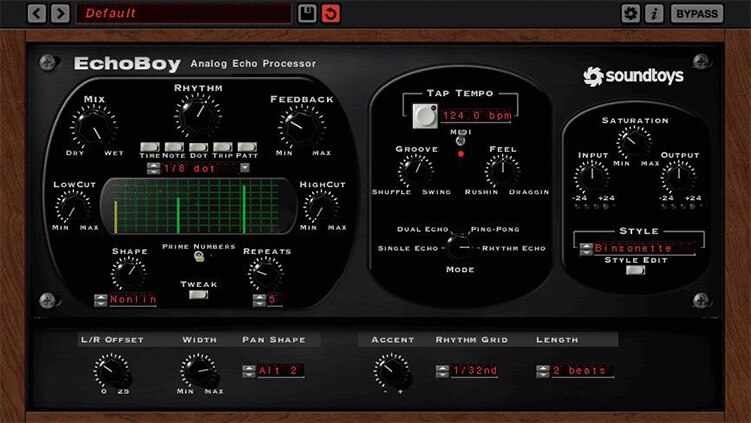
Based on classic echo machines of the past such as the Space Echo, DM-2 and Memory Man, Soundtoys EchoBoy continues to be at the forefront of technological advancement despite its throwback approach. With its rich feature set and intuitive interface, it rightfully ranks high on this list for many compelling reasons.
The GUI is easy to use even for those who don’t have extensive experience with plugins. All the major delay controls – mix, feedback and time – are easy to access and intuitive, and they’re conveniently located in one window so you don’t have to switch between different menus. There are some additional settings, but all the information remains on one page, which is really convenient.
The sound itself that EchoBoy provides is something special. Yes, it has that analog warmth that bare-bones mixers crave, but even just by using the presets, you’ll find that your vocal track suddenly takes on a more expressive character. It emulates the sound of old echo devices, but has its own unique character, making it a modern classic.
8. Native Instruments Replika XT
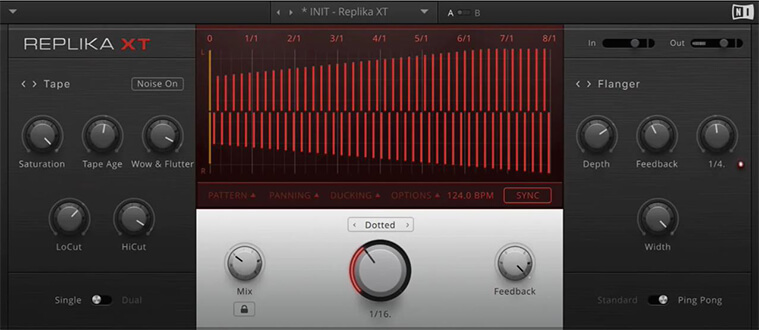
At first glance, Native Instruments Replika XT is a very simple delay plugin. There aren’t a ton of options for endless customization, just simple and easy to use delay sound effects. But despite its apparent simplicity, there are some surprising opportunities for deep customization hidden beneath the surface.
The intuitive interface makes it easy to customize delay sounds, with basic controls for tempo and EQ in the center, effects on the right, and effects-specific options on the left. Moreover, there are options for separate dry and delay signal adjustments, pattern adjustment, time shift, and even fade in single signal mode.
With delay models like Tape, Analog, and Diffusion, you have a wealth of sonic possibilities at your fingertips, and that’s before you even start applying effects. You can add seven different modulation processors, such as chorus, phase effects, and filters, to give your sounds a unique look or simply color them while keeping the sound interesting.
9. FabFilter Timeless 3
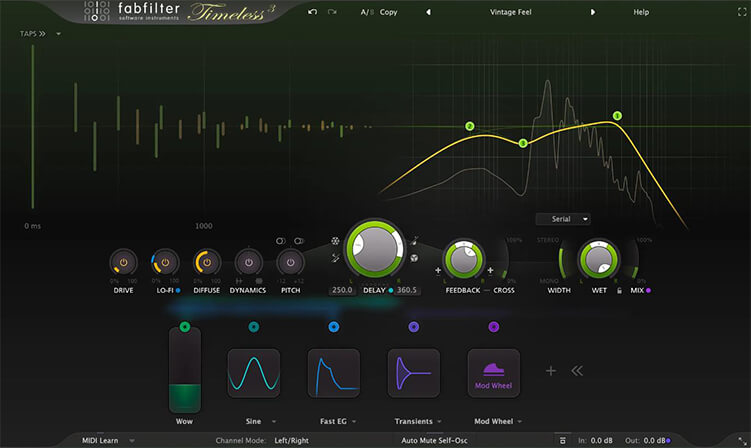
The FabFilter Timeless 3 is often associated with the “vintage tape delay” tag, but it actually goes beyond that classification. Sure, it does a great job of recreating the sound of analog delay, but once you start working with it, you quickly realize that there’s a lot more to it than that, and it can create sounds that are far removed from traditional ones.
The plugin’s interface is surprisingly simple, despite the depth of its functions. Dual concentric controls located in the center of the GUI allow you to easily control delay, feedback and mix parameters, as well as make tempo and pan adjustments from one convenient control. Visual indicators for delay time and EQ settings are provided at the top of the screen, while a variety of modulation options are available at the bottom of the interface.
Separation and filter grids provide a huge amount of customization options, and that’s before you even start using automation in your DAW. The modulation section supports up to 50 modulators, meaning the only limit to your delay sounds is your own imagination.
Considering the available features and cost, this delay plugin should be in every producer’s arsenal.
10. Cherry Audio Stardust 201
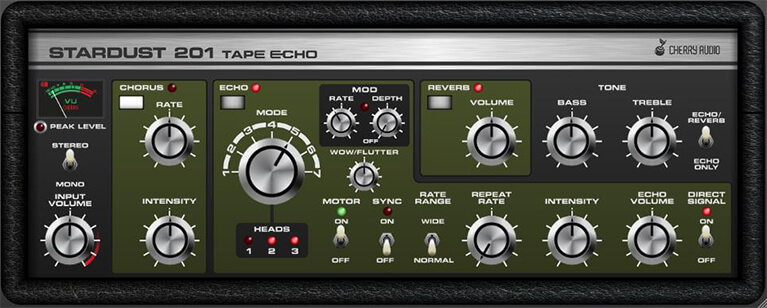
There are a number of emulations of the famous Roland Space Echo, but Cherry Audio’s Stardust 201 comes very close to the original without breaking the bank. This plugin has all the great features of the original, plus a few improvements to improve usability, making it a great tool for creating tape echo sounds.
When you launch the interface, you will see a familiar picture that is familiar to many mix engineers and producers. LED indicators show the active status of each playback head, and a mono/stereo switch adds convenience. There is also a MIDI control section, which makes this plugin more versatile.
Stardust 201 has all the hallmarks of a true Space Echo, including the pitch bend, wah and flutter effects that have made it a classic effect. Plus, it successfully recreates a dub-type effect when you adjust the intensity control.
There may be more accurate emulations out there, but for such an affordable price, you’re unlikely to find anything better than this plugin.
11. Eventide Ultratap
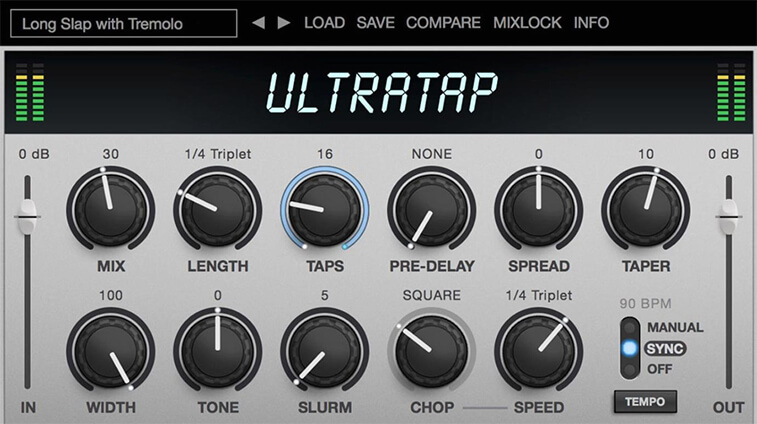
The Eventide Ultratap plugin included in the H9 series provides a simple interface yet is capable of creating the most amazing delay sounds you’ve ever seen. It’s important to note that this is not just a simple tape delay emulation, and its capabilities go far beyond the usual delay effect.
All the controls are on one screen, and while many of them are familiar, you’ll notice one major difference: the lack of a standard feedback control. Instead, it uses “taps” that allow you to adjust the amount of delay effects.
Other fun controls include “slurm”, which is a multi-voice detuning, modulation and reverb control. This plugin also features a variety of other unique effects such as comb filtering, controllable tail delays, airy spatial sounds, and custom-style reverb effects.
12. SSL X-Delay
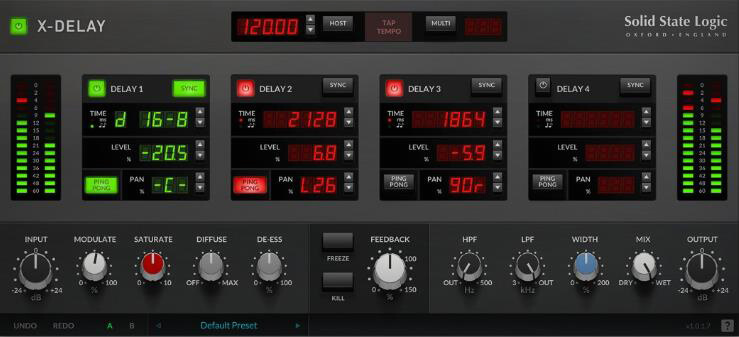
Designed to provide you with a wide range of classic digital delays in a convenient plugin, SSL X-Delay takes inspiration from renowned brands like Lexicon and Roland, providing a full range of delay sounds that you can use to enrich your mixes.
The interface is pleasing to the eye and clearly structured, with four delay controls taking center stage. Here you can adjust the time, level and panning for each delay, allowing you to create many creative delay combinations. Below are additional settings such as high and low pass filters, feedback controls, and modulation options.
All controls are easy to adjust and encourage creative sound exploration. SSL X-Delay goes beyond the classic digital delays it emulates and is an excellent tool for enhancing your mixes.
13. Pulsar Audio Echorec

Built on the classic magnetic drum delay that brought the iconic drum sounds of John Bonham and David Gilmour to the world, the Pulsar Audio Echorec is an outstanding emulation of one of the most famous analog machines ever made.
As in the original, the four tape heads are controlled by a single control, and all possible configurations are represented here. For those who are new to such a device, it may seem a little complicated, but the more you experiment, the faster you will find your favorite settings. You also have access to typical delay options such as feedback and mix, as well as the ability to add drive and adjust platter speed.
The delay sound is dark but still vibrant, and you’re given three modes to experiment with. Echo mode disables the feedback control, allowing you to hear each tape only once; Rip mode activates feedback, creating stunning self-sustaining sounds; and Swell mode sends signals from all four heads to the output, creating an effect reminiscent of reverb.
14. Softube Tape Echoes

By combining several classic tape recorders together, Softube Tape Echoes gives you access to both classic and modern sounds, allowing you to fine-tune the harmonic content of your tracks or achieve powerful effects right out of the box.
A slider sets delay intervals, and tempo and tempo sync are available if you need fine-tuning. Below is a set of controls that allow you to adjust delay settings, add mud and drive to enhance the character of the sound, and adjust whether or not it works in parallel processing mode.
Particular attention is paid to the Drive and Dirt sections; they represent the main focus of this delay processing. Drive adds great richness to the sound, while Dirt controls the latency pattern, allowing you to create the ultra-lo-fi sound you desire. While some users might wish for more control, the ease of use makes it easy to apply effects quickly, preventing you from getting overwhelmed by a plethora of knobs and switches.
15. Soundtoys Crystallizer
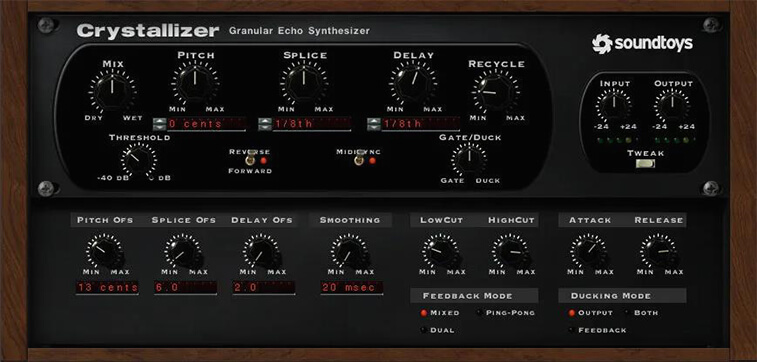
We debated for a long time whether to include this plugin in our list, as it goes far beyond the usual delay effects. However, if your goal is to create custom, grainy, and pitch-shifted sounds to take your mixes to the next level, then Soundtoys’ Crystallizer is one of the most amazing plugins in the world.
Crystallizer is based on the Reverse Shift algorithm known from the Eventide H3000 processor. Despite its hint of 80s influence, this plugin allows you to create deep, rich and modern audio landscapes that cannot be compared to anything else.
While this isn’t the type of plugin that’s used every day, as it’s not designed for creating conventional slapbacks or delays, if your production needs a bit of sound design or you want to add unique tonal pads or ambience, then Crystallizer is the perfect source for your creative work.
Tips for choosing a delay plugin
If this is your first time choosing a delay plugin, keep in mind that this is just the beginning of your journey. Delay is an incredibly useful effect to have in any producer’s arsenal. It can be used to enhance the sound of a mix or create stunning and endlessly oscillating noise vortexes if you like that sound.
There are many different types of delays, so it is important to familiarize yourself with their specifics before making a purchasing decision. All of the delay plugins discussed in this article can certainly improve your mixes, but the key is to know when and how to use them in your creative process.
What does a delay plugin do?
Both reverb and delay are temporary effects, and many of their uses overlap for this reason. The main difference between the two is that reverb creates the illusion of physical space, while delay takes the original signal and plays it back with a slight delay.
However, some delays can create reverb-like sounds, and some reverberations can be so short that they can be considered a delay. In most cases, these two effects can be used together to add a sense of space and liveliness to your mix.
How can I use delay to create a sense of depth in my mix?
There are many ways to use delay, and each mix offers its own potential for experimenting with this effect. However, there are some classic ways to use delay that can improve your tracks.
A common mistake many producers make is using too much reverb, which can hide the natural essence of the sound. If you’re worried that too much reverb will overpower your sounds, consider replacing it with delay. Delays can add a sense of space without adding weight to the sound, making your track more dynamic.
Using delay on drums and other percussive elements can greatly enrich the rhythm of a track. Many delay plugins allow you to sync them to the tempo of your DAW, allowing you to create unique rhythmic elements and transform common sounds like a hi-hat into something new and interesting.
It’s important to experiment with delay to see what effects it brings. You will learn what works in practice and what doesn’t. Try turning the delay on and off as you listen to the mix to get an idea of how it affects the overall feel of the song, and try not to spend too much time listening to individual elements, as this doesn’t always reflect the overall character of the track.



